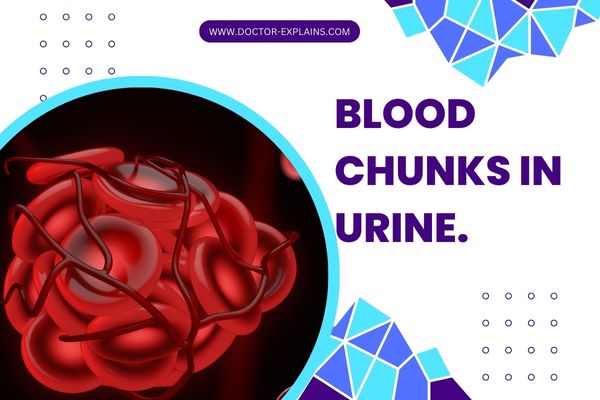Blood Clots in Urine, Key Facts:
- Blood clots in urine may look like small tiny red particles, larger bloody chunks, worm-like red strings, or multiple large clots with frank hematuria.
- The size and number of blood clots often reflect the severity of bleeding.
- The main causes of blood clots in urine are urinary tract stones, trauma, UTI, cancers, etc.
- The main complications of blood clots in stones are obstruction of the urine outflow (urine retention), anemia, and bleeding manifestations.
- The most dangerous cause of blood clots in urine is cancer (especially bladder cancer). Risk factors include being male, older, a smoker, or having chronic bladder inflammation.
A. What does a blood clot in urine look like?
1. Small blood clots.

The most common form of blood clots in urine is small (often the size of sand) reddish clots in yellowish, pinkish, or light red urine.
These small clots are often few and resolve without significant complications. However, as a rule of thumb, always arrange a visit to your urologist or nephrologist if you see any form of blood or blood clots in your urine.
The most common cause of tiny blood clots in urine is urinary tract stones and infections. However, the most dangerous cause is urinary tract cancer (particularly blood cancer).
2. Stringy or worm-like clots.
Stringy or worm-like blood clots are commonly seen in patients with hematuria. These elongated blood clots often mean that the clots are of ureteric origin.
In males, it may also be of urethral origin (the blood clots take the shape of the longer and narrower urethral in men).
Common causes of worm-like blood clots in urine are stones, UTI, prostatic diseases (in men), and cancer.
3. large clots (bloody chunks)

Large blood clots in urine (in the size of rice or beans) usually mean heavier focal inside the urinary tract (reference). This type of bleeding is NOT typical for UTI.
It occurs due to causes of heavy bleeding such as bladder cancer, large stones, or trauma to the urinary tract.
If the condition is associated with dark red urine (frank hematuria), go to the ER immediately.
4. Frank hematuria with many blood clots.
The heaviest form of hematuria is peeing blood or very dark red urine resembling blood with large blood clots (called frank hematuria).
This form of bleeding often occurs with trauma to the kidney or urinary tract. It also occurs due to cancers (such as bladder cancer).
Patients with medical interventions may also lead frank hematuria. Examples include:
- Cystoscopy and bladder biopsy.
- Kidney biopsy.
- Stone extraction operations or lithotripsy.
- Prostatic biopsy or operations.
5. Mimics of blood clots in urine.
You should also consider mimics of blood clots in urine if you see dark, bloody chunks in your urine.
Vaginal bleeding (due to menses or gynecological diseases) is often in the form of blood clots that may appear in the toilet water and be mistaken for blood clots in urine.
In such cases, you will often have no urinary symptoms such as burning urination or turbid urine. Also, the urine is often normal in color (yellowish) and not pinkish or red.
Paying attention to the source of a blood clot in females is important, especially for menstruating or experiencing vaginal bleeding for any other cause.
B. Causes of Blood clots in urine?
1. Kidney or urinary tract stones.
Stones are the most common cause of heavy bleeding, leading to blood clots in the urine. In addition, kidney, ureteric, or bladder stones may cause injury to the lining of the urinary tract with subsequent heavy bleeding and blood clots. The most common symptoms are:
- Kidney stones cause loin pain (in the flanks and upper back on both sides).
- Bladder stones often cause central pelvic pain (urinary bladder pain).
- Ureteric stones cause severe flank pain that radiates to the groin and the inner thigh.
- Some cases are completely asymptomatic and may present with isolated blood in the urine.
- The pain is often sudden onset, severe, and colicky and may last minutes to hours.
2. Severe Urinary tract infection.
Urinary tract infections are common (especially in females). They manifest by burning and, frequent urination, pain in the lower abdomen or flanks. Also, patients often have frequent urges to pee, turbid or bloody urine.
3. Cancers of the urinary tract.
Cancer bladder, kidney, ureter, or prostate may lead to blood clots in urine. The most common type is bladder cancer, which usually manifests with painless hematuria in older people (reference).
4. Trauma to the urinary tract.
Trauma due to accidents or medical interventions may also lead to blood clots in urine (especially if the trauma is severe.
Common examples include:
- Taking a biopsy from the kidney, bladder, or prostate.
- Major trauma to the urinary tract, such as road traffic accidents or falls from height.
- Interventions such as cystoscopy, stone extraction, etc.
4. Exercise-induced hematuria.
Vigorous or strenuous sports are a common cause of hematuria. They often cause mild and self-limiting hematuria. If clots are present, they are often in the form of small or tiny clots in urine.
Common sports include prolonged running (Marathons), cycling, or vigorous contact sports such as boxing.
5. Prostatic conditions (in males).
Prostatic disease or interventions are a common cause of blood clots in urine. Commonly:
- Severe benign prostatic hypertrophy.
- Acute prostatitis (infection or inflammation of the prostate).
- Prostate cancer.
- Transurethral resection of the prostate (TURP).
5. Endometriosis (in females).
Endometriosis describes the presence of uterine lining mucosa in abnormal locations such as the urinary bladder or the ureter in females. This is a common cause of hematuria and blood clots in females. [Learn More].
6. Others.
The causes of hematuria and blood clots in urine are endless. This article discussed all the possible causes of blood clots in urine.
C. Complications of blood clots in urine?
Blood clots in urine are signs of heavy focal bleeding inside the urinary tract. Tiny blood clots in urine often pass without complications.
However, larger blood clots in urine may cause complications such as:
- Blocking the urethra leads to urine retention (inability to urinate).
- Blocking one of the two ureters blocks the urine outflow from that kidney (leading to flank pain on the same side of the blocked ureter).
- Heavy recurrent bleeding with blood clots may rarely lead to anemia.
- Frank hematuria may also lead to bleeding, such as shock (low blood pressure), severe shortness of breath, lightheadedness, or coma. However, it is very rare.
D. What to expect when you visit your doctor.
If you first experience blood clots in urine, you MUST plan a visit to your doctor. Your doctor should identify the cause of blood clots in urine.
Your urologist will often take your history, including the severity and frequency of blood clots, associated symptoms, and any past medical or drug history.
Also, he will perform a clinical examination of the kidney and the urological symptoms.
Frequently needed laboratory investigations to include:
- Complete blood count.
- Prothrombin concentration, bleeding time, and clotting time.
- Urine analysis and culture.
- Kidney function test (urea and creatinine).
Frequently performed imagining studies include:
- Abdominal ultrasound.
- CT of the urinary tract and the kidney (CT KUB).
- MRI.
If the cause isn’t identified by laboratory and imaging techniques, your doctor may perform a cystoscopy to visualize any urinary bladder masses or ulcers.
The treatment depends on the cause. For example, urinary tract stones are left to pass or may need interventions such as lithotripsy, double-J stents, or surgery.
UTI-related blood clots often improve after the proper antibiotics.
UB cancer will often need extensive investigations to identify the degree of cancer spread (staging of cancer). Surgery, chemotherapy, and radiotherapy are used according to the cancer stage.











